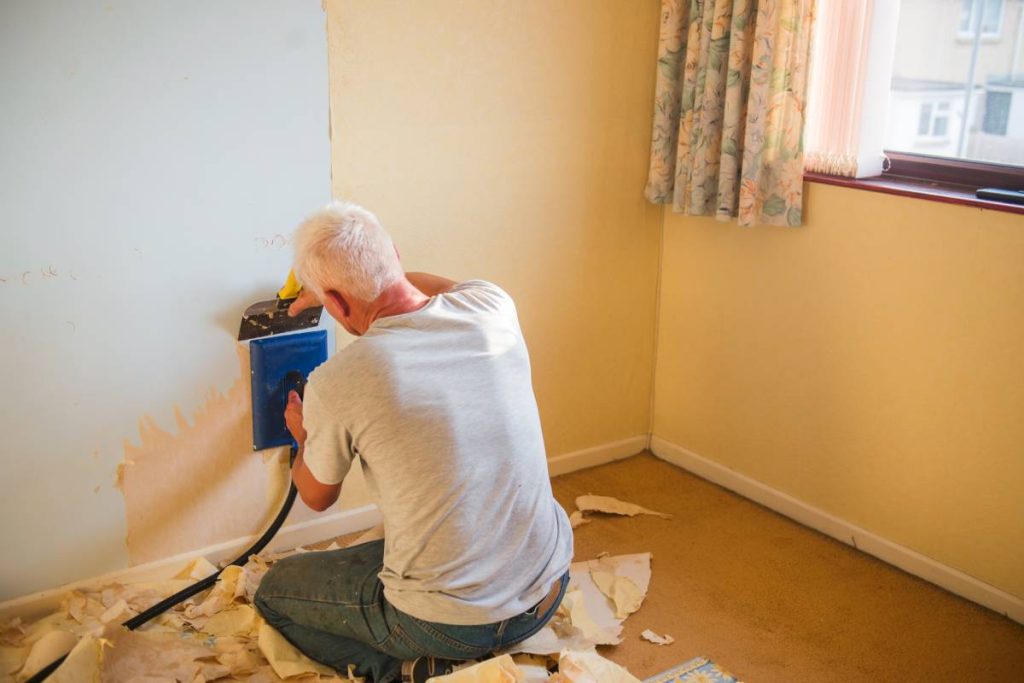Taking down wallpaper may seem complicated at first, but it’s actually quite manageable. Patience is key, as it’s a repetitive task. Plan your approach and decide on the method you prefer. Consider three methods, gather the necessary tools and materials, and choose the one that suits you best.
Before you start, keep in mind that all three methods involve soaking the wallpaper, leading to drips on the floor. To protect your floors and baseboards, use towels, cardboard, or a drop cloth to catch the wet paper and drips.
A word of caution: If you’re removing wallpaper from plaster walls or if the wallpaper is from before the 1980s, the wall paint used before the 1980s might contain lead. Lead-based paint can be harmful, especially in older homes. Take precautions and wear an N95 respirator if you suspect your wall coverings date back to before the 1980s.
Related article: Is it OK to tint house windows? Which tint is best for your home? Is DIY window tinting worth it?
3 Effective Ways to Your Wallpaper Removal
Method 1: Steam Removal
Get the Steamer Ready
- Fill the steamer with water up to the marked waterline. Don’t overfill.
- Attach the handle and hose to the large steamer plate.
- Plug in the machine and turn it on.
- Wait for the steam to build up (usually indicated by lights) for about 5 to 10 minutes.
Steam the Wallpaper
- Tape down plastic sheets to protect your floors and baseboards.
- Place the steamer plate on a section of wallpaper and press the trigger for 15 to 20 seconds.
- Remove the plate immediately.
Remove the Wallpaper
- Peel up the steamed section with a putty knife.
- If it’s stubborn, score the wallpaper with a scoring tool, steam again, and try peeling.
- Repeat until all the wallpaper is gone.
CAUTION: Avoid refilling a hot wallpaper steaming tool to prevent potential eruptions or spills of scalding water, which may result in burns. Wait until the tool is entirely cool before adding more water.
Clean Up the Adhesive
- After removing the paper, re-steam to scrape off any leftover adhesive.
- Once the adhesive is gone, use a fresh, damp sponge to wipe down the wall.
Method 2: Water and Vinegar
Mix the Solution
- Combine equal parts white vinegar and water in a spray bottle.
Saturate the Wallpaper
- Generously spray the vinegar water solution on a section of the wallpaper.
- Once it’s soaked, the paper will come off easily.
Method 3: Liquid Stripper
Apply the Stripper
- Tape plastic on the floor to protect it.
- Turn on the wallpaper stripper nozzle.
- Spray the product and use a sponge to spread it over a 2×2 feet area.
- Wait five minutes for the product to penetrate the paper.
- Wipe away any drips.
Start Removing
- Gently lift the paper with a putty knife, avoiding scraping or gouging.
- If it doesn’t come off easily, score the wallpaper with a scoring tool (about ten holes per square inch).
Repeat the Process
- Apply more stripper and wait five minutes.
- Repeat lifting the wallpaper with the putty knife as needed.
Clean Up Residual Bits
- If adhesive remains, use the stripper.
- Spray it on, wait five minutes, then scrape off the liquefied adhesive with a putty knife.
- Wipe down the wall with a clean, damp sponge.
Wallpaper Removal Tips
- Avoid Painting Over Wallpaper:
- Never paint a room by layering paint over wallpaper. This makes future wallpaper removal much more challenging.
- Handling Plaster Walls:
- For plaster walls, use a wallpaper steamer for optimal removal. Be cautious not to leave the steamer on for more than 30 seconds at a time, as prolonged use can lead to plaster cracking.
- Dealing with Drywall:
- Removing wallpaper from drywall can be tricky due to their similar composition. To protect the drywall, carefully slide a scraper or putty knife between the paper and the drywall, lifting off excess paper and adhesive.
- Consider Previously Painted Drywall:
- Wallpaper removal from painted drywall is easier if the drywall was previously painted with semi-gloss or gloss paint, as it makes the drywall paper less porous.
- Understanding Wallpaper Adhesives:
- Most wallpaper adhesives contain modified wheat starch, which breaks down with hot water. A steamer is an effective method for removing wallpaper, especially in larger rooms.
- Vinegar Water Method:
- When using the vinegar water method, saturate the wallpaper generously with the solution for best results.
- Patience is Key:
- Regardless of the method chosen, patience is crucial. Removing wallpaper can be a time-consuming and challenging task, so take your time to ensure a thorough job.
